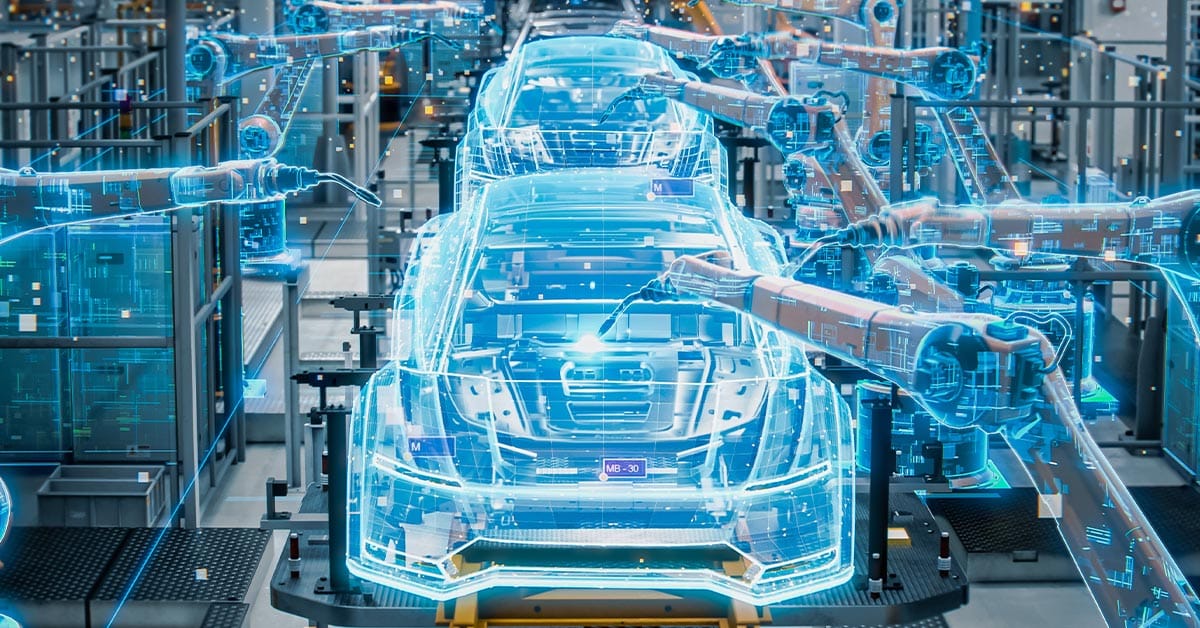The automotive industry is experiencing rapid change. Technology continues to evolve, electric vehicle demand continues to grow and shift the market share balance, and manufacturers remain on the hunt for efficiencies and process improvements. In the face of such upheaval — all in the pursuit of meeting consumer needs and remaining competitive — it can prove difficult to make the necessary operational adjustments required to keep up. Augmented reality is helping car manufacturers to do so in these areas and more.
How AR works for automotive manufacturing
Augmented reality in car manufacturing can take numerous forms with an extensive range of applications. AR can augment, scan and support productivity in areas such as:
- 3D modeling, prototyping and testing: With AR, car manufacturing R&D can operate much more efficiently with the ability to “place” 3D models into real-world assemblies and existing products to test for fit, form and function.
- Assembly kitting: Automotive production lines often make use of kitting for particular assemblies and components. AR can help to ensure that kits are picked and packed correctly and that assembly workers follow the correct steps.
- Training: With augmented reality, automotive training and production manuals can easily be uploaded to be readily available directly via the AR device. Beyond static manuals, AR can support libraries of training videos and can even facilitate direct communication between on-site workers and off-site experts if specialized maintenance or production expertise is required.
- Maintenance: AR in maintenance can provide repair manuals at the technician’s fingertips, along with heads-up readouts of inventory levels, maintenance resource availability and access to off-site experts who can walk on-site technicians through highly specialized procedures.
- Quality control: AR can display the acceptable parameters for parts and components coming off the line, making it easier for quality control personnel to compare and identify potential part errors, as well as potential production issues if recurring error conditions persist.
Benefits & applications of AR in automotive manufacturing
Benefits of AR for automotive manufacturing includes:
- Improve and standardize training: Inconsistent and insufficient training are among the primary culprits of avoidable production errors. When training is done on an ad-hoc basis without a standardized process or source of truth, the effects of bad practices throughout the facility can become compounded, creating excess downtime, wasted resources and missed deadlines. With AR, manufacturers can create robust, standardized training programs that enable effective hands-on training for new hires through the ability to “handle” virtual parts and components in augmented real-world situations without posing a risk to production efficiency. AR training also frees up more experienced personnel throughout the facility to continue performing tasks that more directly create value for the customer.
- Optimize manufacturing processes: From production design through to quality control, AR can help manufacturers find efficiencies in every area of their processes. Because AR devices take the form of an “always-on,” heads-up display, employees who are supported by AR can create higher quality, more accurate output at a higher rate of speed, yielding vast potential benefits in productivity and performance metrics.
- Increase productivity & sales: Starting with faster time to market through more effective prototyping and testing, continuing to increased productivity and uptime, and through to more effective QC and fulfillment processes, AR has the potential to boost sales through more efficient production. With faster production, increased innovation and higher-quality output, manufacturers can improve customer satisfaction and retention, increase sales volume and gain a reputational boost that can lead to further new business.
Integrating AR with automation
In today’s manufacturing facilities, automation collaboration — for example, with collaborative robots and human employees working side-by-side — is helping to harness the value of both of these resources: the speed and efficiency of automation, along with the incomparable expertise and problem-solving of workers. AR integration further boosts the cross-functional effectiveness of this collaboration, enabling, for example, human workers to “see” what the collaborative robot “sees,” and to carry out tasks that much more quickly.
Because so much automation relies on vision systems, industrial AR glasses can easily piggyback on this technology to increase the efficiency and quality of assemblies, fulfillment, sorting, QC and more.
Real-life examples of AR in automotive manufacturing
AR is not only the future of automotive manufacturing, this technology is making an impact right now. Some examples include:
Ford’s Advanced Manufacturing Center: Located in Redford, Michigan, this $45 million facility opened in 2018 with a focus squarely on AR, robotics and 3D printing to spur innovation through prototyping and testing. With simulated AR production lines, cobots and a vast array of 3D printers for on-demand design iteration, Ford is banking on this facility as the next step forward for their historic place in the industry. Flagship vehicles including the Shelby Mustang GT500 and the F-150 Raptor include 3D printed parts developed at the Advanced Manufacturing Center.
Toyota’s AR Training: Toyota has gone all-in on augmented reality for training, partnering with Microsoft to deliver the technology and knowledge that they need to be as effective and productive as possible. Toyota has seen efficiency gains in training, improvements through AR “hands-on” experience before working on the production line and seamless access to training materials from anywhere.
Fiat Chrysler’s ImMErsive Technology Room: Located in Turin, Italy, this facility is Fiat Chrysler’s most innovative R&D outlet, operating as a full virtual laboratory powered by AR, going far beyond vehicle production itself and applying the technology to optimize plant layout and configuration for maximum efficiency. AR also enables collaboration across different areas of the facility, as well as different facilities worldwide. Engineers and designers can collaborate, modify and iterate in real time to come up with the most innovative products possible.
The digital transformation in the automotive industry is happening — if interested in learning more about technology-driven industrial maintenance — contact ATS today.






